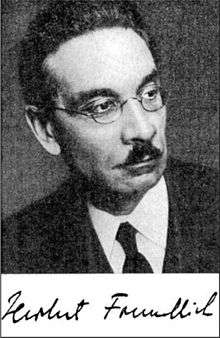Herbert Freundlich
| Herbert Freundlich | |
|---|---|
 Herbert Freundlich | |
| Born |
January 28, 1880 Charlottenburg |
| Died |
March 30, 1941 (aged 61) Minneapolis |
| Fields | Chemistry |
| Institutions |
Kaiser Wilhelm Institute for Physical Chemistry and Electrochemistry University of Minnesota |
| Notable students | Robert Havemann |
Herbert Max Finlay Freundlich ForMemRS[1] (28 January 1880 in Charlottenburg – 30 March 1941 in Minneapolis) was a German chemist.[2][3]
His father was Jewish descendable German, and his mother (Finlay) was from Scotland. His younger brother was Erwin Finlay Freundlich (1885–1964)
He was director of the Kaiser Wilhelm Institute for Physical Chemistry and Electrochemistry from 1919 until 1933, when the racial policies of the Nazi party demanded the dismissal of non-Aryans from senior posts. In 1934 he became foreign member of the Royal Netherlands Academy of Arts and Sciences.[4]
Emigrating to England, Freundlich accepted a guest professorship at University College London. Five years later, he accepted a professorship at the University of Minnesota. He died in Minneapolis two years later.
His most prominent student was Robert Havemann who became a well known colloid chemist of the German Democratic Republic.
Freundlich's main works dealt with the coagulation and stability of colloidal solutions. His work is of continuing importance, with his 1906 paper "Over the adsorption in solution" becoming highly cited at the beginning of the 21st century.[5]
See also
References
- ↑ Donnan, F. G. (1942). "Herbert Freundlich. 1880-1941". Obituary Notices of Fellows of the Royal Society. 4 (11): 27–26. doi:10.1098/rsbm.1942.0004.
- ↑ Reitstötter, J. (1954). "Herbert Freundlich". Kolloid-Zeitschrift. 139: 1–3. doi:10.1007/BF01502318.
- ↑ Gortner, R. A.; Sollner, K. (1941). "Herbert Freundlich 1880-1941". Science. 93 (2418): 414–416. doi:10.1126/science.93.2418.414. PMID 17842472.
- ↑ "H. Freundlich (1880 - 1941)". Royal Netherlands Academy of Arts and Sciences. Retrieved 17 July 2015.
- ↑ Q. Ke; et al. (2015). "Defining and identifying Sleeping Beauties in science". Proc. Natl. Acad. Sci. USA. 112: 7426–7431. doi:10.1073/pnas.1424329112.
External links
- Works by or about Herbert Freundlich at Internet Archive
- Herbert Freundlich - Did you know that the man of science Herbert Freudlich was also a composer?
- Ausstellungstafel der TU Berlin zu Prof. Freundlich
- Otto Hahns Rolle als Interimsdirektor des KWI für Physikalische Chemie und Elektrochemie 1933. Ein Vorabdruck aus dem Forschungsprogramm „Geschichte der Kaiser-Wilhelm-Gesellschaft im Nationalsozialismus"